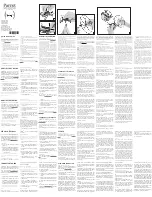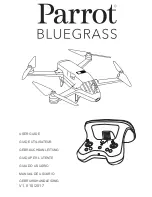
PRISM FLIGHT MANUAL
121
RPAS Care should be a priority for the pilot and ground crew. Care for the RPA is part of
the preventative maintenance program and will ensure a reliable and long life for the RPAS.
The steps below detail procedures for the correct care of the RPA.
1. PRISM should be transported in the case provided by the manufacturer, or in a similar
case which provides the same cushioning, immobilization, stability, and level of
protection against dust, moisture, or foreign-object debris as the manufacturer’s case.
2. It may be necessary to lift and carry the assembled, flight-ready PRISM from one
place to another in the field, and to manipulate the aircraft during compass calibration.
Lifting PRISM should be done by two persons, who should grasp the aircraft at the
base of opposing structural arms. Never lift PRISM by the motors or the extremities
of the arms unless lifting all four arms simultaneously. If it is necessary for one person
to lift and carry PRISM, that person should approach the aircraft from the back, stand
between the two rear arms of the aircraft, and grasp the two opposite arms at either
side of the airframe at their base, nearest the center of the aircraft.
3. If it is necessary to move PRISM manually in the field, it is recommended to fold and
bag the propellers to prevent damage or injury. The person manipulating the aircraft
should be cautious of the payload, which may move freely if not secured or powered
on.
4. PRISM should be regularly cleaned of dust and debris accumulated during missions.
This is best accomplished using a clean, dry or slightly damp cloth to remove dust.
Small amounts of grease or lubricant may be applied periodically to the pivoting arm
joints where they attach to the central airframe. Screws which are frequently removed
and reinserted, such as the bolts holding the boom arms to the airframe, should be
treated with medium- strength thread locker, which should be re-applied when the
adhesive
flakes
off
the
threads.
5. During standby periods, ensure the RPA is not exposed to direct sunlight and the
motors are covered to protect from dust or dirt.
6. Do not operate the RPA in excessively dusty or sandy conditions. If necessary, make
use of a landing pad to limit dust created during takeoff and landing.
7. When operating near the coast, limit the RPA’s exposure to sea air when not in use.
9.4 RPAS CLEANING AND CARE
Summary of Contents for PRISM R.P.A.S.
Page 3: ...PRISM FLIGHT MANUAL 3 INTENTIONALLY LEFT BLANK...
Page 5: ...PRISM FLIGHT MANUAL 5 INTENTIONALLY LEFT BLANK...
Page 7: ...PRISM FLIGHT MANUAL 7 INTENTIONALLY LEFT BLANK...
Page 18: ...PRISM FLIGHT MANUAL 18 Figures 5 6 PRISM PAYLOAD AND FLIGHT TIME CALCULATIONS...
Page 21: ...PRISM FLIGHT MANUAL 21 Figure 7 RPA ORIENTATION DURING TAKEOFF LANDING...
Page 47: ...PRISM FLIGHT MANUAL 47 Figure 8 PRISM POWER CIRCUIT DIAGRAM...
Page 53: ...PRISM FLIGHT MANUAL 53...
Page 54: ...PRISM FLIGHT MANUAL 54...
Page 57: ...PRISM FLIGHT MANUAL 57 Figure 14 20 WATTSQGC APPLICATION SETTINGS GENERAL...
Page 67: ...PRISM FLIGHT MANUAL 67 Figure 31 COMPASS CALIBRATION SCREEN...
Page 81: ...PRISM FLIGHT MANUAL 81 Figure 46 47 USER SELECTABLE TELEMETRY VALUES FOR HUD...
Page 84: ...PRISM FLIGHT MANUAL 84 Figure 50 51 WATTSQGC PRE FLIGHT CHECKLIST...
Page 103: ...PRISM FLIGHT MANUAL 103 Assembled battery pack Smaller battery assembly Assembled battery pack...
Page 106: ...PRISM FLIGHT MANUAL 106 Battery Packs Top Mounted Battery Packs Bottom Mounted...
Page 136: ...PRISM FLIGHT MANUAL 136 SUPPLEMENT 1...
Page 137: ...PRISM FLIGHT MANUAL 137 SUPPLEMENT 2A...
Page 138: ...PRISM FLIGHT MANUAL 138 SUPPLEMENT 2B...
Page 139: ...PRISM FLIGHT MANUAL 139 SUPPLEMENT 3...









































